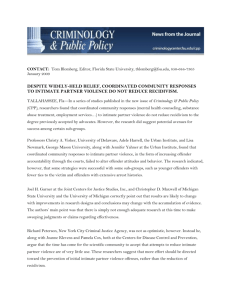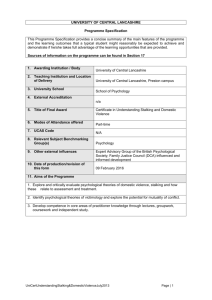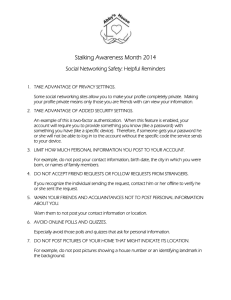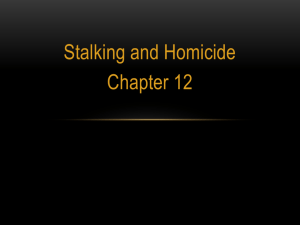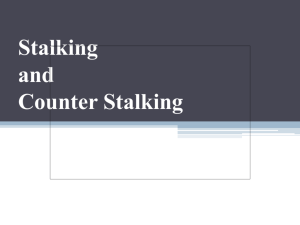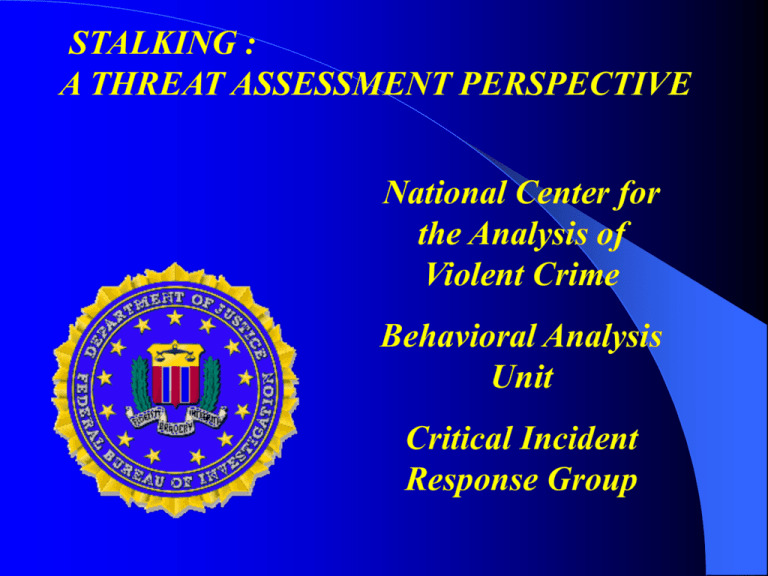
STALKING :
A THREAT ASSESSMENT PERSPECTIVE
National Center for
the Analysis of
Violent Crime
Behavioral Analysis
Unit
Critical Incident
Response Group
THE NATIONAL
CENTER FOR THE
ANALYSIS OF
VIOLENT CRIME
Supervisory Special Agent
Eugene A. Rugala
National Center for the Analysis of
Violent Crime
Behavioral Analysis Unit
Critical Incident Response Group
FBI Academy
Quantico, Virginia
703-632-4321/ grugala@hotmail.com
TOPICS TO BE DISCUSSED:
The role of the National Center for the
Analysis of Violent Crime in the assessment
of threats.
Nature and type of threats
The Behavioral Assessment Process in the
assessment of various types of threats
Overview of Stalking
Stalker Typologies
Criminal
Investigative
Analysis
Process of reviewing and assessing
the facts of a criminal act, and
interpreting offender behavior and
interaction with the victim, as
exhibited during the commission of
the crime, or in the crime scene.
Behavior Reflects
Personality
The method and manner in which a
crime is committed, relates directly to the
personality of the offender.
TYPES OF CASES WHERE
CIA MAY BE USEFUL
HOMICIDES
SEXUAL ASSAULTS
CHILD ABDUCTIONS/KIDNAPPINGS
ARSONS/BOMBINGS
PRODUCT TAMPERING
THREATS
CRIMINAL INVESTIGATIVE
ANALYSIS-PRODUCTS:
CRIME ANALYSIS
UNKNOWN
OFFENDER
PROFILE
INVESTIGATIVE
STRATEGIES
INTERVIEW
STRATEGIES
THREAT
ASSESSMENTS
SEARCH WARRANT
ASSISTANCE
PROSECUTIVE
STRATEGIES
EXPERT
TESTIMONY
Criminal
Investigative
Analysis Process
Research
Experience
in
Similar
Cases
+
Training Education
Case
Specific
Analysis
=
WHAT IS THREAT
ASSESSMENT?
IT IS AN ATTEMPT TO EXAMINE THE ELEMENTAL
PARTS OF A VERBAL OR WRITTEN THREAT,
IN ORDER TO ASSESS THE GENUINENESS AND
OVERALL VIABILITY OF THE EXPRESSION OF AN
INTENT TO DO HARM.
THREAT ASSESSMENT
WITHIN THE NCAVC
IN UNKNOWN OFFENDER CASES, THE ANALYSIS OF
WRITTEN, TYPE-WRITTEN, TAPE-RECORDED, AND
COMPUTER-GENERATED THREATS MADE AGAINST
PERSONS, PLACES OR THINGS
IN KNOWN OFFENDER CASES, THE ANALYSIS OF
BEHAVIOR EXHIBITED BY HIM/HER TO ASSESS
POTENTIAL FOR VIOLENCE
DEFINITION OF STALKING
Repeated pattern of harassing behaviors
Intention to frighten, intimidate, or terrorize
a particular victim
Men and women are the perpetrators
HARASSING BEHAVIORS
CAN INCLUDE:
Surveillance
Lying in Wait
Non-consensual Communication
Telephone Harassment
Vandalism
Use of the Computer to Harass and/or
Threaten an Individual
MOST STALKING LAWS
REQUIRE:
The perpetrator must make a credible threat of violence
Against the victim; Others include threats against the victims
Immediate family; Still others require only that a course of
Conduct engaged by the alleged stalker constitute an implied
Threat.
STALKING PREVALENCE
LIFETIME VICTIMIZATION
RATES
The National Violence of Women Survey found the following:
8.1% of Women and 2.2% of Men have been stalked at least
once in their lifetime based on 16,000 respondents.
Based on U.S Census Bureau estimates, one out of every 12
Women and one out of every 45 Men, or 8.2 million and 2.0
Million respectively have been stalked sometime in their
Lifetime.
MOST WOMEN ARE
STALKED BY:
38% by Current or Former Husbands.
10% by Current or Former Cohabitating Partners.
14% by Current or Former Dates or Boyfriends.
Overall, 59% were stalked by some type of Intimate
Partner.
STALKING BEHAVIOR IS AN
INTEGRAL PART OF
DOMESTIC VIOLENCE
IN 80% OF THE CASES
INVOLVING INTIMATE
PARTNERS, THE STALKING
EITHER STARTED OR
CONTINUED AFTER THE
WOMEN LEFT THE
RELATIONSHIP.
INTIMATE PARTNER
VIOLENCE
In 1998, 1 Million Violent
Crimes were Committed
Against Persons by their
Current or Former Spouses,
Boyfriends, Girlfriends.
About 85% of Victimizations
by Intimate Partners were
Against Women
In 1998, About 1830
Murders were Attributable to
Intimate Partners
In 1998, Women were
Nearly 3 Out of 4 Victims of
the 1830 Homicides
The Percentage of Female Murder
Victims Killed by Intimate Partners
has remained at 30% since 1976
(National Crime Victimization Survey May 2000)
BATTERER TYPOLOGIES
POWER AND CONTROL BATTERERS
MENTALLY ILL BATTERERS
CRIMINAL - PSYCHOPATHIC
BATTERERS
(Walker, 1996)
POWER AND CONTROL
Violence Mostly in Homes
Motivated by Abnormal Power and
Control Needs
MENTALLY ILL BATTERERS
Abnormal Power and Control
Severe Psychological Problems
Depression
Disordered Thinking
Obsessive – Compulsive Disorder
Paranoid Disorders
CRIMINAL –
PSYCHOPATHIC
BATTERERS
Commit Assaults Within the Home
Commits Other Non-Violent and Violent
not Limited to the Home
Often Diagnosed with Anti-Social
Personality Disorder.
OFFENDER
CHARACTERISTICS
Jealous and Extremely
Possessive
Manipulative
Blames Others
Unable to take No for
an answer
Sense of Entitlement
Unable to Cope with
Rejection
Dependent on the
Victim for Sense of
Self
Narcissistic
Views Himself as a
Victim
Mood Swings
Deceptive
Needs to be in Control
LATEST RESEARCH
SUGGESTS:
Violence Risk in Prior Sexual Intimates is
High
Homicide Rates Among Stalkers are Low
In Domestic Cases, Stalkers Who Pose a
Threat Will Often Make a Threat
In Public Cases, Stalkers Who Pose a Threat
will Usually Not Make a Threat
(Meloy 2002)
LATEST RESEARCH
SUGGESTS:
Three Predictive Factors for Stalking Violence:
Prior Criminal History
Drug Abuse/Dependency
Prior Sexual Intimacy
Two Other Related Factors:
No Mental Disorder
Threats
(Meloy 2002)
STALKER TYPOLOGIES
SIMPLE OBSESSIONAL
LOVE OBSESSIONAL
EROTOMANIC
FALSE VICTIMIZATION SYNDROME
( Zona, Palarea, and Lane )
SIMPLE OBSESSIONAL
Most Common Typology
Prior Relationship
Perception of Mistreatment on part of
Offender
Personality Disorder
Short Duration
Volatile
LOVE OBSESSIONAL
No Prior Relationship
Usually Known Through Media
Delusional Disorders Common
Long Duration
Offenders Mostly Male
EROTOMANIC
Delusional Disorder
Rare
No Prior Relationship
Long Duration
Offenders Mostly Female
FALSE VICTIMIZATION
SYNDROME
Victim Becomes Suspect
Fictitious
Rare
Attention and/or Attempt to ReEstablish Existing Relationship Primary
Motives
STALKER TYPOLOGIES
The typology can be viewed as a continuum based
on the following:
Dimension of the degree of relationship of the Stalker to the
Victim.
Stranger Vs. Non-Stranger
Dimension of Mental Health Issues.
Delusional Vs. Non-Delusional
(Douglas, Wright Et Al)
Lethality Indicators
Symbolic Violence
Physical Violence
Location of Violence
Strangulation
Surveillance/Control
Threats
Children
Fear
Suicidal or Homicide
Ideation
Status of Relationship
Orders of Protection
Resisting Arrest
Availability of Weapons
Substance Abuse
Stressors
Mental Illness
Desperation
Decreased Focus
Depersonalization
National Center for the Analysis of Violent Crime
Behavioral Analysis Unit
Critical Incident Response Group
SSA EUGENE A. RUGALA
FBI Academy
Quantico, Virginia 22135
703-632-4321
grugala@hotmail.com




